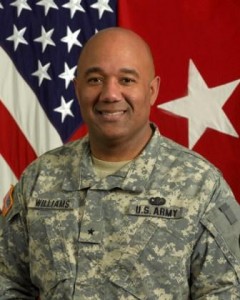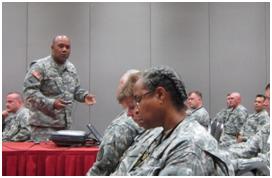By BG Darryl A. Williams, WTC Commander
Wow! The Army Medical Command Training Symposium in San Antonio was great. San Antonio is the home of Army Medicine as well as home to some of the warmest and friendliest people in the world. It was a pleasure to be here and to participate in this event.
For three days we focused on partnerships and had the privilege of hearing some incredible speakers, including Surgeon Vice Admiral Philip I. Raffaelli, Surgeon General, Queens Honorary Physician; the Honorable Eric Shinseki, Secretary of Veterans Affairs; Lt Gen Charles B. Green, Surgeon General, U.S. Air Force; RADM Christine S. Hunter, Deputy Director of TRICARE Management Activity; and LTG David P. Fridovich, Deputy Commander, U.S. Special Operations Command–just to name a few.
LTG Fridovich addressed the general session on the last day of the event and shared his personal story about pain medication with us. His story is inspiring and powerful. He put a face on a serious issue that impacts the Army and our nation.
LTG Eric Schoomaker, Commander, Army Medical Command and Army Surgeon General, stopped by the Warrior Transition Command (WTC) track and talked for quite awhile with the more than 100 WTC and warrior transition unit attendees. He told them he understood the difficulties of their jobs, the value of what they do every day to contribute to the healing and transition of wounded, ill, and injured warriors, and thanked them for their service. He reminded them to take care of themselves, took questions, and discussed issues from pharmaceuticals to pain management and cadre to Soldier ratios.
I can say I consider the Army Medical Command Training Symposium a success for WTC. We launched the new WTC video at our exhibit and as a result gave away several hundred copies. We also took numerous orders for the new Comprehensive Transition Plan brochure. While I’m on this topic, l want to offer a shout-out of thanks to a couple of Army Wounded Warrior Program Soldiers, Shilo Harris and Juan Guerrero, who showed up to share their personal stories with folks who stopped by our exhibit. They are extraordinary and I appreciate their support.
A special thank you also goes out to Robert Carrington, Director of Recovery Care Coordination, Office of Wounded Warrior Care and Transition Policy, Department of Defense (DOD), who addressed our attendees on Tuesday. His office is one of our most valuable partners and we share the goal of ensuring that we don’t just heal our warriors, but that we ensure job placement. It was great to have him on the agenda—he reiterated to us the continued commitment of DOD to this population and reminded us of the valuable skills these men and women bring to the federal and private sector job markets.
This symposium gave me the opportunity to meet with colleagues, staff, and friends from across the Army. I couldn’t be more pleased with the WTC track. Thank you to all of the people in MEDCOM who made the symposium happen and especially to my staff whose hard work and dedication resulted in a very productive WTC track. You all made sure we had an environment that was conducive to very candid discussions on a host of topics such as warrior transition units, community based warrior transition units, caregiver support, personnel issues, and nonprofit agency support for warriors and their Families. It was a great week for the Warrior Transition Command in the home of Army Medicine!



